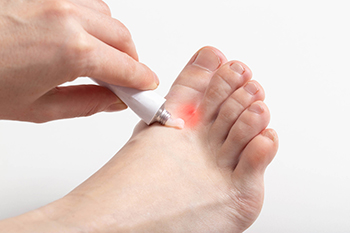6650 Frankford Ave
Philadelphia, PA 19135

Athlete’s foot, often referred to as tinea pedis, is a fungal infection of the foot. The cause of this affliction is fungi getting into the skin from hot, humid environments. It can be as simple as fungus growing inside of shoes or socks that one wears and sweats in. This ailment is common among teens and young adults as they tend to sweat more and wear shoes for longer periods of time. This infection can be picked up by walking barefoot in warm and humid communal areas, such as locker rooms and poolside. It also can come from not drying feet well after swimming, bathing, or exercising. Usually, athlete’s foot symptoms occur between the 4th and 5th toes. The skin can be cracked, sore, and itchy, appear white and soggy, and may flake. In advanced cases of athlete’s foot, the skin can become quite sore and even bleed. This condition can also spread to the soles and sides of the foot and affect toenails, which can become thick, brittle, and yellow. If left untreated, athlete’s foot can lead to secondary bacterial infections. If you suffer from athlete’s foot, it is important to see a podiatrist immediately.
Athlete’s foot is an inconvenient condition that can be easily reduced with the proper treatment. If you have any concerns about your feet and ankles, contact John M. Fanelly, DPM from Northeast Philadelphia. Our doctor will treat your foot and ankle needs.
Athlete’s Foot: The Sole Story
Athlete's foot, also known as tinea pedis, can be an extremely contagious foot infection. It is commonly contracted in public changing areas and bathrooms, dormitory style living quarters, around locker rooms and public swimming pools, or anywhere your feet often come into contact with other people.
Solutions to Combat Athlete’s Foot
Athlete’s foot can cause many irritating symptoms such as dry and flaking skin, itching, and redness. Some more severe symptoms can include bleeding and cracked skin, intense itching and burning, and even pain when walking. In the worst cases, Athlete’s foot can cause blistering as well. Speak to your podiatrist for a better understanding of the different causes of Athlete’s foot, as well as help in determining which treatment options are best for you.
If you have any questions please feel free to contact our office located in Philadelphia, PA . We offer the newest diagnostic and treatment technologies for all your foot and ankle needs.